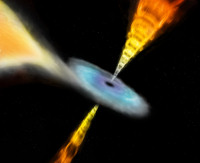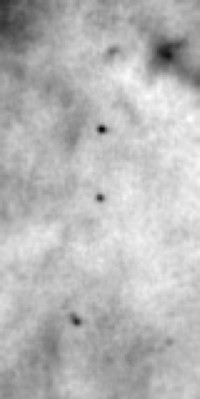Herschel gets to the bottom of black-hole jets
12 March 2013
Astronomers using ESA's Herschel space observatory have detected emission from the base of black-hole jets for the first time. While studying the black-hole binary system GX 339-4 in a multi-wavelength observation campaign, they noticed changes in the source's X-ray and radio emissions signalling the onset of powerful jets being released from the black hole's vicinity. This prompted the astronomers to observe the source at far-infrared wavelengths with Herschel. As the first observation of emission from jets in a black-hole binary system at these wavelengths, the data have allowed the astronomers to probe the jets down to their base, where the far-infrared emission originates. Herschel's contribution to the multi-wavelength observations has proved a crucial addition to the understanding of black-hole jets and of the physical processes that take place very close to a black hole.
 |
|
Artist's impression of the GX 339-4 black-hole binary system. |
When black holes – the densest objects in the Universe – accrete matter from their surroundings, they also trigger the release of powerful jets of highly-energetic particles that stem from the accretion disc into outer space. This phenomenon happens both at the stellar-mass black holes that derive from the death of massive stars and at the supermassive black holes lurking at the centre of massive galaxies. The physical mechanisms underlying the outburst of jets and their connection with the accretion process, however, are still unclear although astronomers have been studying them for decades, first via observations at radio wavelengths and, more recently, across the entire electromagnetic spectrum.
Stellar-mass black holes that are accreting mass from a companion star in a binary system are of great help to astronomers interested in the dynamics of jets. Since they are much smaller than their supermassive counterparts, stellar-mass black holes give rise to jets whose properties change on relatively short time scales – of the order of a few hours or days – providing astronomers with a great opportunity to study their evolution and, possibly, the ignition mechanisms that trigger the appearance of jets.
"One of the best-studied stellar-mass black holes is the one hosted in the binary system GX 339-4: we can monitor its evolution quite closely because the source gives rise to bright outbursts every couple of years," explains Stéphane Corbel from Laboratoire AIM, France. Corbel led a new study of this system based on far-infrared (FIR) data from ESA's Herschel Space Observatory, as well as on observations performed at X-ray, optical, near-infrared (NIR) and radio wavelengths.
"The multi-wavelength approach is essential for us to explore the vicinity of black holes, as different regions radiate at different wavelengths. Broadly speaking, the accretion disc shines most brightly in X-rays, whereas the jets emit mainly radio waves. But there is more: the base of the jets – closer to the black hole – emit light at shorter wavelengths than radio waves, up to the infrared: this is where Herschel's contribution proved crucial," Corbel adds.
While GX 339-4 has been studied extensively at radio, NIR, optical and X-ray wavelengths, astronomers had rarely observed it in the vast portion of the spectrum between radio and NIR wavelengths. In fact, until now hardly any data from any stellar-mass black hole had been collected in this broad wavelength range.
The astronomers requested to observe GX 339-4 with Herschel after they detected changes to its X-ray emission signalling that the outburst phase of this source, which had been going on for several months, was about to cease. Since timing was essential, the observations were performed under Director's Discretionary Time.
 |
|
Herschel image of the GX 339-4 black-hole binary system. Credit: ESA/Herschel/PACS/S.Corbel et al. |
"We believe that black-hole binaries give rise to outbursts when enough material has piled up in the accretion disc: then, just like a dam that bursts because it can no longer hold any more water, the material is accreted onto the black hole, giving rise to an enormous increase of the source's emission at soft X-ray wavelengths," explains Corbel.
The outburst phase, also known as 'soft' state, is accompanied by the release of 'ballistic jets' – jets that are very bright at radio wavelengths, consist of multiple ejections and extend up to
"We had been monitoring GX 339-4's outburst across the electromagnetic spectrum for several months. When we saw that it was transitioning to a more quiescent state, we were extremely curious to see what would happen to the jets," says Corbel.
"It is the first time that we could witness the onset of compact jets and follow their evolution," he adds. "By combining radio observations with Herschel's FIR data, we could probe the jet emission down to the base, very close to the black hole."
The Herschel data confirmed the current view, based on radio observations, which explains the emission from jets as synchrotron radiation released by highly-energetic electrons. In particular, the most energetic electrons, present at the base of the jets, radiate at FIR wavelengths, whilst the lower-energy ones, which are more abundant at larger distances from the black hole, give rise to radio emission.
The new data, however, raise questions about what causes the emission detected at NIR and optical wavelengths; this emission is also associated with the jets but does not seem to have the same origin as the radio and FIR emission. Since the optical and NIR emission follows that at radio and FIR wavelengths, one of the possible explanations is that radio and FIR photons emitted in the jets are then reflected off the disc, gaining energy in the process and thus radiating at shorter wavelengths.
"With this result, Herschel has filled a long-standing gap in the monitoring of stellar-mass black-hole jets across the electromagnetic spectrum, bridging observations performed at radio and near-infrared wavelengths," comments Göran Pilbratt, Herschel Project Scientist at ESA. "This new view complements our current picture of these fascinating objects, while highlighting, at the same time, how their emission is even more complex than previously thought," he concludes.
Notes for editors
The study presented here is based on observations of the black-hole binary system GX 339-4 performed at 70 and 160 microns with the Photodetector Array Camera and Spectrometer (PACS) on board ESA's Herschel Space Observatory. The data were gathered under Director's Discretionary Time on 25 February and 6 March 2011.
GX 339-4 is a binary system hosting a 7-solar-mass black hole that accretes mass from its companion, a low-mass star. The system is located at a distance of about
In this study, the Herschel observations were combined with data from a multi-wavelength campaign aimed at monitoring GX 339-4 across the electromagnetic spectrum; the team of astronomers used data from NASA's Rossi X-Ray Timing Explorer (RXTE) and Swift satellites to study the source's X-ray emission, from the SMARTS 1.3-m telescope at Cerro Tololo Inter-American Observatory, located in Chile, to observe the source at optical and near-infrared wavelengths, and the Australia Telescope Compact Array to study its radio emission.
Herschel is an ESA space observatory with science instruments provided by European-led Principal Investigator consortia and with important participation from NASA. The PACS instrument contains an imaging photometer (camera) and an imaging spectrometer. The camera operates in three bands centred on 70, 100, and 160 μm, respectively, and the spectrometer covers the wavelength range between 51 and 220 μm. PACS has been developed by a consortium of institutes led by MPE (Germany) and including UVIE (Austria); KU Leuven, CSL, IMEC (Belgium); CEA, LAM (France); MPIA (Germany); INAF-IFSI/OAA/OAP/OAT, LENS, SISSA (Italy); IAC (Spain). This development has been supported by the funding agencies BMVIT (Austria), ESA-PRODEX (Belgium), CEA/CNES (France), DLR (Germany), ASI/INAF (Italy), and CICYT/MCYT (Spain).
Related publications
S. Corbel, et al., "Formation of the compact jets in the black hole GX 339-4", 2013, Monthly Notices of the Royal Astronomical Society, in press
Contacts
Stéphane Corbel
Laboratorie AIM (CEA/IRFU, CNRS/INSU, and Université Paris Diderot)
Gif-sur-Yvette, France
Email: stephane.corbel![]() cea.fr
cea.fr
Phone: +33-1-6908-4562
Göran Pilbratt
Herschel Project Scientist
Research and Scientific Support Department
Science and Robotic Exploration Directorate
ESA, The Netherlands
Email: gpilbratt![]() rssd.esa.int
rssd.esa.int
Phone: +31 71 565 3621


